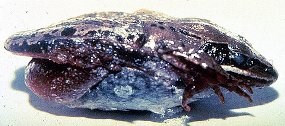Written by Kennedy Zittel, Woodland Dunes intern
Halloween is almost here! With that being said, I have another scary tale to share. This time it is about zombies! Picture this, it is mid-winter, the temperature is well below freezing, ponds have frozen over, and snow is piled all around. Below the soil and water there lies a creature who has frozen solid, whose heart has stopped beating, and who has long since stopped breathing. It certainly sounds like that creature has croaked. Fast forward to spring, the temperature is rising, the sun begins to shine more, and the ground and ponds begin to thaw. To your horror, the creature mentioned earlier unburies itself and rises to the surface. Ah! But, it is just a frog. No worries though, there really is no such thing as a zombie frog, but frogs and toads do possess a unique adaption that allows them to be able to survive the harsh winter.
 Frogs and toads are coldblooded, meaning that their body temperature will become the temperature of the environment around them. Imagine your body turning the same temperature as the weather outside, brrr! During the winter, frogs and toads will go into a state of hibernation. One common myth about how aquatic frogs hibernate is that they will burrow themselves completely under the mud, however, if the frogs were to go completely under the mud they would not have enough oxygen to survive. Aquatic frogs instead spend the majority of winter either lying on top of the mud or partially buried in mud so that they can reach the oxygen-rich water. Terrestrial frogs and American Toads (Wisconsin’s only toad species) will often hibernate on land by burrowing deep into the soil below the frost line. Terrestrial frogs that are not as well adapted to digging, like the Spring Peeper, will seek out cracks or crevices in rocks and logs to hibernate in instead. The Wood Frog hibernates closest to the surface which is why you will hear their calls the earliest in the spring as they are usually the first then to emerge.
Frogs and toads are coldblooded, meaning that their body temperature will become the temperature of the environment around them. Imagine your body turning the same temperature as the weather outside, brrr! During the winter, frogs and toads will go into a state of hibernation. One common myth about how aquatic frogs hibernate is that they will burrow themselves completely under the mud, however, if the frogs were to go completely under the mud they would not have enough oxygen to survive. Aquatic frogs instead spend the majority of winter either lying on top of the mud or partially buried in mud so that they can reach the oxygen-rich water. Terrestrial frogs and American Toads (Wisconsin’s only toad species) will often hibernate on land by burrowing deep into the soil below the frost line. Terrestrial frogs that are not as well adapted to digging, like the Spring Peeper, will seek out cracks or crevices in rocks and logs to hibernate in instead. The Wood Frog hibernates closest to the surface which is why you will hear their calls the earliest in the spring as they are usually the first then to emerge.
How do the frogs come back to life then, if they aren’t actually zombies? Well, the frogs never technically die, even though their breathing and heart do stop. They actually end up completely frozen solid (like a frog-cicle!) as the weather gets well below freezing. As ice crystals begin to form underneath the frog’s skin parts of the frog’s body will begin to freeze completely solid. The only part of a frog or toad that does not freeze completely is their vital organs. A large concentration of glucose within a frog’s vital organs will act as a natural antifreeze thus preventing vital organs like the heart and lungs from fully freezing. When the weather warms up to above freezing, the frogs and toads will begin to thaw, their hearts will begin to beat once more, their lungs will begin to work again, and come spring they will unbury themselves and rise to the surface. The ability that frogs and toads have (along with other coldblooded animals of the area) to be able to survive after freezing allows them to live in the toughest of winter climates that would have us scrambling for our heaviest winter coats. Which in my opinion, is toad-ally awesome!
photo of a frozen wood frog from National Park Service
